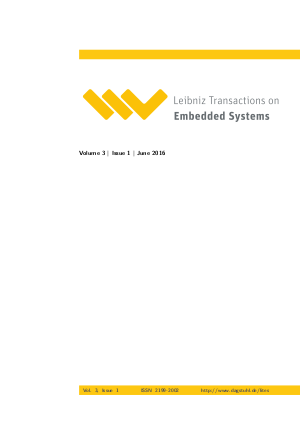Leibniz Transactions on Embedded Systems, Volume 3, Issue 1
LITES, Volume 3, Issue 1
-
Part of:
Volume:
LITES, Volume 3
Journal: Leibniz Transactions on Embedded Systems (LITES)

Publication Details
- published at: 2016-06-10
- Publisher: Schloss Dagstuhl – Leibniz-Zentrum für Informatik
- DBLP: db/journals/lites/lites3
Access Numbers
- Detailed Access Statistics available here
-
Total Document Accesses (updated on a weekly basis):
0PDF Downloads
Documents
LITES, Volume 3, Issue 1
Abstract
Cite as
LITES, Volume 3, Issue 1, pp. 1-152, Schloss Dagstuhl – Leibniz-Zentrum für Informatik (2016)
Copy BibTex To Clipboard
@Article{LITES-v003-i001,
title = {{LITES, Volume 3, Issue 1}},
journal = {Leibniz Transactions on Embedded Systems},
pages = {1--152},
ISSN = {2199-2002},
year = {2016},
volume = {3},
number = {1},
publisher = {Schloss Dagstuhl -- Leibniz-Zentrum f{\"u}r Informatik},
address = {Dagstuhl, Germany},
URL = {https://drops.dagstuhl.de/entities/document/10.4230/LITES-v003-i001},
doi = {10.4230/LITES-v003-i001},
annote = {Keywords: LITES, Volume 3, Issue 1}
}
Programming Language Constructs Supporting Fault Tolerance
Abstract
Cite as
Christina Houben and Sebastian Houben. Programming Language Constructs Supporting Fault Tolerance. In LITES, Volume 3, Issue 1 (2016). Leibniz Transactions on Embedded Systems, Volume 3, Issue 1, pp. 01:1-01:20, Schloss Dagstuhl – Leibniz-Zentrum für Informatik (2016)
Copy BibTex To Clipboard
@Article{houben_et_al:LITES-v003-i001-a001,
author = {Houben, Christina and Houben, Sebastian},
title = {{Programming Language Constructs Supporting Fault Tolerance}},
journal = {Leibniz Transactions on Embedded Systems},
pages = {01:1--01:20},
ISSN = {2199-2002},
year = {2016},
volume = {3},
number = {1},
publisher = {Schloss Dagstuhl -- Leibniz-Zentrum f{\"u}r Informatik},
address = {Dagstuhl, Germany},
URL = {https://drops.dagstuhl.de/entities/document/10.4230/LITES-v003-i001-a001},
URN = {urn:nbn:de:0030-drops-192560},
doi = {10.4230/LITES-v003-i001-a001},
annote = {Keywords: Fault tolerance, Functional safety, PEARL, Embedded systems, Software engineering}
}
Real-Time Scheduling on Uni- and Multiprocessors based on Priority Promotions
Abstract
Cite as
Risat Mahmud Pathan. Real-Time Scheduling on Uni- and Multiprocessors based on Priority Promotions. In LITES, Volume 3, Issue 1 (2016). Leibniz Transactions on Embedded Systems, Volume 3, Issue 1, pp. 02:1-02:29, Schloss Dagstuhl – Leibniz-Zentrum für Informatik (2016)
Copy BibTex To Clipboard
@Article{pathan:LITES-v003-i001-a002,
author = {Pathan, Risat Mahmud},
title = {{Real-Time Scheduling on Uni- and Multiprocessors based on Priority Promotions}},
journal = {Leibniz Transactions on Embedded Systems},
pages = {02:1--02:29},
ISSN = {2199-2002},
year = {2016},
volume = {3},
number = {1},
publisher = {Schloss Dagstuhl -- Leibniz-Zentrum f{\"u}r Informatik},
address = {Dagstuhl, Germany},
URL = {https://drops.dagstuhl.de/entities/document/10.4230/LITES-v003-i001-a002},
URN = {urn:nbn:de:0030-drops-192575},
doi = {10.4230/LITES-v003-i001-a002},
annote = {Keywords: Real-Time Systems, Priority Promotion, Schedulability Analysis, Schedulability Condition}
}
Modeling Power Consumption and Temperature in TLM Models
Abstract
Cite as
Matthieu Moy, Claude Helmstetter, Tayeb Bouhadiba, and Florence Maraninchi. Modeling Power Consumption and Temperature in TLM Models. In LITES, Volume 3, Issue 1 (2016). Leibniz Transactions on Embedded Systems, Volume 3, Issue 1, pp. 03:1-03:29, Schloss Dagstuhl – Leibniz-Zentrum für Informatik (2016)
Copy BibTex To Clipboard
@Article{moy_et_al:LITES-v003-i001-a003,
author = {Moy, Matthieu and Helmstetter, Claude and Bouhadiba, Tayeb and Maraninchi, Florence},
title = {{Modeling Power Consumption and Temperature in TLM Models}},
journal = {Leibniz Transactions on Embedded Systems},
pages = {03:1--03:29},
ISSN = {2199-2002},
year = {2016},
volume = {3},
number = {1},
publisher = {Schloss Dagstuhl -- Leibniz-Zentrum f{\"u}r Informatik},
address = {Dagstuhl, Germany},
URL = {https://drops.dagstuhl.de/entities/document/10.4230/LITES-v003-i001-a003},
URN = {urn:nbn:de:0030-drops-192584},
doi = {10.4230/LITES-v003-i001-a003},
annote = {Keywords: Power consumption, Temperature control, Virtual prototype, SystemC, Transactional modeling}
}
Optimal Scheduling of Periodic Gang Tasks
Abstract
Cite as
Joël Goossens and Pascal Richard. Optimal Scheduling of Periodic Gang Tasks. In LITES, Volume 3, Issue 1 (2016). Leibniz Transactions on Embedded Systems, Volume 3, Issue 1, pp. 04:1-04:18, Schloss Dagstuhl – Leibniz-Zentrum für Informatik (2016)
Copy BibTex To Clipboard
@Article{goossens_et_al:LITES-v003-i001-a004,
author = {Goossens, Jo\"{e}l and Richard, Pascal},
title = {{Optimal Scheduling of Periodic Gang Tasks}},
journal = {Leibniz Transactions on Embedded Systems},
pages = {04:1--04:18},
ISSN = {2199-2002},
year = {2016},
volume = {3},
number = {1},
publisher = {Schloss Dagstuhl -- Leibniz-Zentrum f{\"u}r Informatik},
address = {Dagstuhl, Germany},
URL = {https://drops.dagstuhl.de/entities/document/10.4230/LITES-v003-i001-a004},
URN = {urn:nbn:de:0030-drops-192593},
doi = {10.4230/LITES-v003-i001-a004},
annote = {Keywords: Real-time systems, Scheduling, Parallel tasks}
}
A Survey on Static Cache Analysis for Real-Time Systems
Abstract
Cite as
Mingsong Lv, Nan Guan, Jan Reineke, Reinhard Wilhelm, and Wang Yi. A Survey on Static Cache Analysis for Real-Time Systems. In LITES, Volume 3, Issue 1 (2016). Leibniz Transactions on Embedded Systems, Volume 3, Issue 1, pp. 05:1-05:48, Schloss Dagstuhl – Leibniz-Zentrum für Informatik (2016)
Copy BibTex To Clipboard
@Article{lv_et_al:LITES-v003-i001-a005,
author = {Lv, Mingsong and Guan, Nan and Reineke, Jan and Wilhelm, Reinhard and Yi, Wang},
title = {{A Survey on Static Cache Analysis for Real-Time Systems}},
journal = {Leibniz Transactions on Embedded Systems},
pages = {05:1--05:48},
ISSN = {2199-2002},
year = {2016},
volume = {3},
number = {1},
publisher = {Schloss Dagstuhl -- Leibniz-Zentrum f{\"u}r Informatik},
address = {Dagstuhl, Germany},
URL = {https://drops.dagstuhl.de/entities/document/10.4230/LITES-v003-i001-a005},
URN = {urn:nbn:de:0030-drops-192603},
doi = {10.4230/LITES-v003-i001-a005},
annote = {Keywords: Hard real-time, Cache analysis, Worst-case execution time}
}